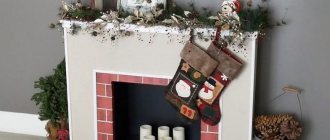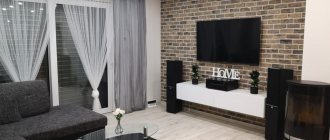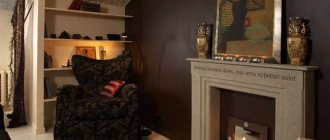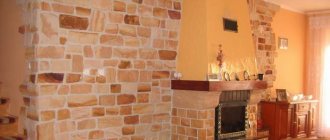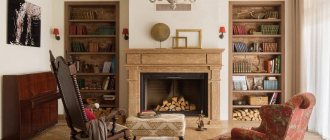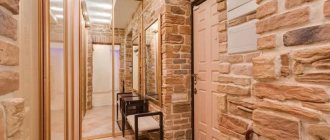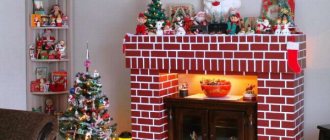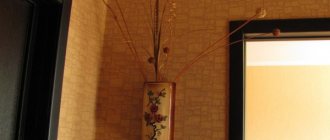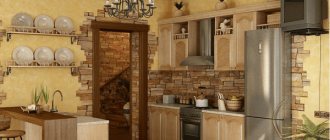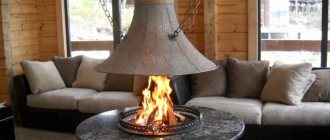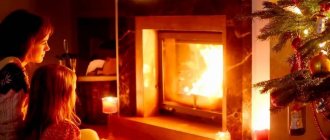A fireplace in a house or country house is a place of attraction for the whole family. It’s clear that you want it to be beautiful, but practicality also doesn’t hurt - soot and soot, dirt or tar from firewood, all this often ends up on the walls of the portal. For this reason, the surface must be easy to clean. In addition, the finish of the fireplace must be heat-resistant - although the sides of the fireplace do not heat up to the same temperatures as the stove, this requirement should not be neglected. Not many materials meet these requirements. This is heat-resistant plaster, special types of ceramic tiles and stone - natural or decorative.
Finishing features
One of the most important requirements for finishing a real fireplace is the fire resistance of the facing material. The structure consists of a hearth (the place where the fire burns) and a portal (the decorative outer part) with a chimney. The item is most often made from clinker - a special heat-resistant stove brick.
The color of the finish also matters. When the fireplace is intended primarily to heat the room, and not to decorate it, the darkest matte tones are preferable. The more textured and embossed the surface is, the stronger the heat transfer, which means the higher the temperature in the room with such a stove.
Benefits of brick
This solution can be seen in almost any bathhouse. The brick finish protects the wall from overheating. Very often this protection is made even more powerful and extended to the floor. Finishing the stove in a bathhouse with brick performs both a protective and decorative function. For it, the same type of brick is taken as for the rest of the stove, or another facing brick of the required appearance is additionally purchased.
The rules for brickwork for walls, the stove and the protective portal around the stove are general.
Strict adherence to row levels and neat and thin seams are necessary.
On the walls and in the oven, bricks are laid with overlapping seams. If the portal is laid out in one layer, then it is not at all necessary to comply with this requirement. This is why you can often see protective portals where bricks are stacked on top of each other.
The horizontal row is checked by level. Covering the wall with bricks is plumb. For a corner stove, three planes are laid out with bricks, two on the walls and one on the floor.
For a stove near the wall, there are only two, of which one is located on the floor, and the second is on one wall. Brick, even if it is laid in one layer, has good thermal insulation ability. Its masonry is carried out directly on wooden walls and floors without other fire-retardant insulation.
It is advisable to lay out the horizontal part of the portal in one row between the foundation of the furnace and the subsequent masonry next to it. This advice should only be followed with brick sauna stoves. It is not suitable for metal ones.
In baths, thick fireproof cardboard, mineralite or basalt wool are most often used. There are also basalt cardboard and other materials that are a variation of the previous ones. Minerite is the most preferred. These are ready-made boards specially designed for thermal protection in areas around stoves.
Types and methods of finishing a fireplace
There are several options for finishing the portal, each of them has its own positive and negative properties. Most often, the hearth is plastered and then painted, lined with decorative ceramic tiles, natural or artificial stone, and sheathed with sheets of metal. The portal itself is often decorated with fireproof glass doors, heavy cast iron gratings, and steel shutters.
The cramped the room, the smaller the decorative hearth is made, the lighter its decoration.
Plastering: advantages, disadvantages
Finishing a fireplace with plaster is not a complicated or expensive process. Suitable for structures made entirely of brick and concrete. This design does not weigh down the object, so there is no need to further strengthen the foundation. The plaster layer, intended for subsequent finishing, is slightly different from the decorative option. When changing the interior, the structure can be easily repainted in a different color that matches the decor. The disadvantage of this finish is that when applying a thick layer, reinforcement is required, as well as long-term drying.
Tiling a fireplace - pros, cons
Very often, fireplaces are lined with ceramic tiles and porcelain stoneware. The latter is placed both directly on the glue and on metal profiles. Using porcelain stoneware it is easy to disguise uneven brickwork, chips, and other surface defects. The material is durable, resistant to frost, open fire, sudden changes in temperature, humidity, physical damage, and retains its beautiful appearance for a long time. The downside is that the price is not the lowest.
Cladding with ceramic tiles is an inexpensive option, since you can make it yourself or choose from the widest assortment now offered by most stores. In shape it is offered in square, rectangular, figured, corner, etc. The material is fire-resistant, environmentally friendly, and it can be chosen to suit almost any interior style. The disadvantage of the material is low impact resistance.
Decorating a fireplace with artificial stone - pros and cons
Artificial stone is cheaper than natural stone and vaguely resembles it in appearance. This material is several times lighter in weight - no additional strengthening of the foundation is needed for it. Frost resistance and resistance to chemicals in most species are also excellent. Fake stone is made from gypsum, stone chips, polymers, imitates granite, marble, onyx, sandstone. The material is easy to install by hand; there are flexible options for curved surfaces. Significant disadvantages - fake stone does not have the thermal conductivity of natural stone, as well as the corresponding characteristics of strength and moisture resistance; it is more fragile.
Finishing with natural stone: positive, negative qualities
Real natural stone is a heavy, beautiful, completely natural material. Such finishing always looks luxurious, it is voluminous, quite complex in execution, but extremely durable - the fireplace will last for more than one generation. It is permissible to install the structure even in a room that is not heated. The stone is abrasion-resistant, impact-resistant, and the variety of types, shapes, and colors allows you to choose it to suit different interior styles.
The construction of a structure on the first floor of a private house requires a reinforced foundation underneath; on the second and subsequent floors it is recommended to install the product at the junction of two main walls. Another disadvantage is the high cost of the material. For cladding use:
- marble;
- granite;
- sandstone;
- shell rock;
- soapstone;
- tuff;
- limestone.
Metal cladding - advantages, disadvantages
Decorating the hearth by sheathing it with metal sheets is suitable for many modern interior styles. The most popular finishing techniques are stainless steel, copper and brass, decoration techniques include broaching, embossing (including hand-made), artistic etching, and plasma cutting. Metals can be easily combined with natural or artificial stone and plaster. The undoubted advantages of such finishing are the relatively light weight of the parts, the ability to decorate the fireplace in almost any interior style (retro, classic, hi-tech, etc.) without completely rebuilding it. A free-standing structure made entirely of metal is easy to connect and place anywhere in the space. The main disadvantages are the likelihood of serious burns when touching a metal surface, uneven heating of the room, and rapid cooling.
Basic requirements for materials
In order for a material to be ideally suited for masonry or cladding, it must meet the following requirements:
Requirements Description Strength
The selected material must have high strength. This is necessary to ensure that the appearance and integrity of the structure remains that way over a long period of operation. If the integrity of at least one element is violated, the tightness of the entire structure is jeopardized. Which can lead to deterioration in functionality and disruption of traction. Fire resistance
The finishing of a brick fireplace should be made exclusively from fire-resistant materials. Refractory brick is able to withstand both the highest temperatures and their sudden changes
At the same time, the material will not deform or collapse, which is very important for the proper functioning of the fireplace installation. On average, brick is exposed to temperatures reaching 900-1000 degrees
Materials with good fire resistance are also distinguished by their good heat dissipation, which allows the stove unit to retain heat for a long time and distribute it evenly throughout all rooms of the house. For better heat release, you can think about building fireplace stoves with increased heat transfer. Smooth surface
The bottom part of each brick must be as smooth as possible and free from cracks and crevices that could disrupt the necessary tightness. Brick laying should be carried out in such a way that the seams and gaps between each element remain minimal. Each brick fits tightly with the previous one. Clutch
The brick for facing the fireplace must adhere well to the surface. To do this, before using the selected material, it is necessary to thoroughly wet each element in water and check its integrity.
How to choose plaster for a fireplace
To decorate the fireplace insert, chimney and other parts, you will need to choose the right plaster. The composition is often mixed independently using the following main components:
- clay – added for heat resistance. It is advisable to choose something that is not too “greasy” - it will quickly crack when the structure being designed is heated;
- sand - it is not afraid of high temperatures, the coating is as durable as possible, its volume is approximately twice as large as clay;
- lime is an excellent plasticizer, improves adhesion to the base, and facilitates the application process. It is recommended to purchase ready-made slaked fluff or make it yourself;
- asbestos, fiberglass - increase the thickness, heat resistance, and strength of the coating. It is preferable to add up to 7-10% natural fiberglass to the solution, even less asbestos, since it is very toxic;
- cement - as a binding component, it is added no more than 50% of the total volume of the mixture, since a larger amount will lead to cracking of the surface.
If you have no experience in preparing multicomponent mixtures, it is better to buy a ready-made plaster composition for stoves.
How to plaster yourself
Plastering the structure yourself is not too difficult. It is only important to choose a special composition - fire-resistant, when heated, does not release harmful substances into the surrounding atmosphere, and does not crack under the influence of high temperatures.
How to perform plastering step by step:
- before starting work, the walls of the structure are cleaned of dirt, degreased, slightly heated, and the masonry is moistened with water;
- then reinforcement is made using a special mesh to make the coating as durable as possible;
- then spray with a liquid solution - this allows you to fill the pores in the brickwork;
- when the layer has slightly set, plastering is carried out - a layer of four to six mm is applied. thick. To do this, use a trowel and a trowel;
- then apply another one or three of the same thin layers and dry;
- The covering is made with the same liquid mixture as the spray; it helps to hide the smallest defects. The plane is leveled until it hardens completely, using a wooden smoother;
- It is permissible to heat the stove after three to four days - speeding up the drying process with kindling is unacceptable, since the coating often cracks;
- the textured coating is made very thin - 0.3-0.7 cm, so that the finishing does not weigh down the structure;
- Decorative plaster is rarely tinted, so you will have to add the paint yourself. It is chosen to be heat-resistant - up to +650 degrees; silicone enamel, which almost never cracks, is best suited.
Preparation of the solution
The solution is the most important element of the entire work. There are 3 options that are often used in work:
- Clay solution. Optimal for brick construction, withstands high temperatures when burning solid fuel. Will last a long time. An important characteristic is the fat content of the clay. The most primitive method of determining it is to check mechanical strength: roll balls from a composition with different ratios of sand and clay, dry completely, and drop each ball onto the floor. The one that will not break is taken as the basis for its composition. To ensure uniformity, the clay is passed through a sieve and kneaded by mixing with water. To achieve the required elasticity, sand and water are added. To mix the mixture, it is recommended to use a drill with a special attachment - this will ensure uniformity of the mass.
- Cement mortar. The composition is popular in use, but is afraid of prolonged thermal exposure - the seams may crack. For the solution, it is necessary to add sand, the amount depends on the brand of cement used. For example, for the M300 the ratio is 3:1. The solution is mixed using a drill. To avoid rapid shrinkage and to give elasticity to the solution, it is recommended to add a pinch of washing powder.
- Dry mixture. A ready-made purchase option, also suitable for finishing a decorative fireplace.
On a note!
It is better if the cladding is attached to the same mortar that was used for the main masonry.
Which tiles are suitable for finishing a fireplace?
Basic selection options:
- impact resistance, wear resistance - directly affect the durability of the coating;
- design – the appearance of the fireplace should match the style of the room;
- moisture resistance – if there is water in the room (sauna, bathhouse);
- resistance to temperature changes - very important if the fireplace is the only source of heating in the room;
- thickness - the more the better, it is recommended that the option is no thinner than eight mm;
- porosity – it is advisable to use low porosity, as it is more durable;
- marking tiles - the use of category “A” is more acceptable, since the dimensions of the product are as accurate as possible, the pattern is clear, which is very important when laying out complex patterns.
There are many types of finishing materials based on ceramic tiles:
- terracotta is a strong and durable material, frost-resistant and vapor-tight. The tiles do not split upon impact, are practically scratch-resistant, are suitable for damp, heated and unheated rooms, and can be attached to any surface. A fireplace decorated with terracotta tiles heats up longer than others, and the coating tolerates sudden temperature changes well;
- tiles - used for highly artistic finishing of stoves, most often covered with glaze, almost any design can be applied. The heat transfer of the product is high, it is easy to care for, but the cost of the material is high;
- porcelain stoneware – combines the best properties of granite and ceramics, is resistant to temperature changes, does not crack, does not mold, does not fade in the sun, and is available in various color options;
- clinker tiles - made from several types of clay, with the addition of fireclay powder. The thickness of the material is 9-13 mm, it is easily installed using hot-melt adhesive, but when decorating a summer kitchen, the latter is frost-resistant. Clinker tiles are low-porous, wear-resistant, impact-resistant;
- majolica - has been used since ancient times; its composition is an improved terracotta, with a pattern applied to it, covered with a transparent glaze. The price of the material is high,
- tiles are heat-resistant and tolerate temperature changes well, but in the cold the material quickly deteriorates and crumbles. Matte options are preferable for fireplaces - they do not crack. Installation is carried out using heat-resistant compounds or without glue - in a metal frame;
- fireclay tiles - made from stone flour and refractory clay, are acid-resistant, fire-resistant, can withstand extremely low temperatures, and do not wear off.
DIY tile installation technology
For self-installation, purchase a special composition - tile adhesive. On the back side of the tiles there are usually special notches that increase the adhesion of the parts to the base. It is recommended to reinforce the structure with large-mesh reinforcing mesh, secured with screws or nails. Next, the mesh is covered with a mixture of sand, clay, high-grade cement, with the addition of polymers. The seams are grouted so that they are even; special plastic crosses are used when laying. The evenness of the coating is checked with a level and plumb line.
Gearbox Dimensions
The thickness of the furnace gearbox is most often 8 mm. Clinker and porcelain tiles for fireplaces can be thinner - 5–6 mm. This material is quite durable, and heat capacity is not so important when finishing a fireplace.
- Tile sizes vary within very small limits. Experts say that CP larger than 25*25 cm should not be used. The number of seams in this case does not matter, and working with large tiles is very inconvenient: there is a lot of trimming, and the heat-resistant glue may not withstand the weight of the material.
- Small tiles - less than 10*10 cm are not used for the same reason: they are too inconvenient to work with. In addition, such finishing crushes the stove surface, and it is not so large.
- Much larger porcelain stoneware slabs are used for facing fireplaces. But, since this material is quite difficult to adjust to size, the cladding elements are made to order.
Now let's find out how the lining of bathhouses, brick, Russian, heating stoves and fireplaces with ceramic tiles (tiles) is carried out.
Choosing artificial stone for finishing
Artificial stone is made from gypsum, synthetic materials, most often with the addition of stone chips. Some of its types are externally indistinguishable from the real thing. High-quality design is achieved with the right choice of materials.
Main criteria:
- price - a good stone is never excessively cheap, but foreign products are always an order of magnitude more expensive than domestic ones;
- goods used for finishing residential premises must have a certificate of conformity and hygiene, and not contain harmful components;
- the longer a manufacturing company exists, the more likely it is that it produces high-quality material;
- the stone should not be too porous - this affects the strength and service life of finishing elements;
- The manufacturer's logo must be indicated on the packaging; the date of manufacture is also important - the optimal strength of the artificial stone is achieved within 28-30 days from the date of manufacture. If the period is shorter, the product is of poor quality, it is better to refuse to purchase it.
Features of working with artificial stone when decorating a fireplace
Decorating a hearth with fake stone has a number of features:
- work is performed at a temperature of at least +6 degrees;
- it is important to use the appropriate adhesive recommended by the manufacturer;
- for cutting use a hacksaw;
- the surface of the product is cleaned, a reinforcing mesh is installed on it;
- then plaster is applied to the mesh, the layer thickness is 0.9-1.5 cm, and dried;
- cladding is done from the corner from top to bottom so that the parts do not get dirty;
- a thick layer of mortar is applied to each part with a trowel, pressed to the place to be decorated, and excess glue is removed;
- it is advisable to use long and short parts in turn, adjusting them with a hacksaw or wire cutters;
- all seams are filled with mortar, dried, and excess is removed;
- After complete drying, the structure is coated with hydrophobic compounds to increase the service life of the coating.
What to make a textured roller from
The work will go faster if you use a brick-like roller instead of a box-shaped one. A penny insulation for pipes made of foamed polypropylene will help you save on tools.
You can make a textured roller for decorative plaster from ordinary wallpaper
We cut insulation of the same diameter into rings 1 cm wide and stretch them onto a rubber cylinder.
It is convenient to cut the material with a paper knife, protecting the floor or table with plywood. The number of rings depends on the size of the roller and the desired width of the “brick”. The larger it is, the narrower the rows of “masonry”.
Choosing natural stone for facing a fireplace
Cladding with real stone involves a wide variety of materials. Marble and travertine, sandstone and granite, tuff and limestone are suitable for work. When choosing the appropriate option, you should remember that smooth materials require less maintenance and cleaning from dirt. Stones such as granite and marble have a significant weight, which will require a very solid foundation for the fireplace. It is equally important that the chosen decor fits well into the interior.
Properties of different stones:
- sandstone is layered, has a wide range of colors (from red-pink to dark gray), changes color when the light changes, and is resistant to temperature changes;
- slate - can be red, yellow, green, brown, black, etc., is relatively expensive, requires periodic treatment with dirt-repellent mixtures;
- travertine - usually yellowish-gray in color, porous, not too dense, therefore to improve its properties it is coated with special compounds;
- granite is the most durable, reliable, durable, resistant to impacts, chemicals, and temperature changes. The color range is from white-gray to almost black, from pale yellow to dark burgundy. The price is very high, but the appearance is strict and solid;
- marble looks luxurious, but is expensive. Colors – white, gray, black, variegated. The material easily tolerates temperature changes and physical influences, but is not resistant to aggressive chemicals or household dyes, therefore it needs a special coating;
- Onyx is a semi-precious stone, the presence of which in a room makes it unique. The material transmits light perfectly, comes in yellow, green, orange, brown, is resistant to high and low temperatures, but chemicals are destructive to it, and the cost is about three times more than other stones.
Rules for working with marble and other natural stones
Working with real stone, be it marble, granite, sandstone or others, is labor-intensive. Each tile will have to be carefully adjusted in size and selected according to tone. To work, you will need special grinding machines and stone-cutting devices.
Installation order:
- the surface of the stove is cleaned of dirt, a reinforcing mesh is installed;
- facing elements are adjusted so that all tiles are the same size, shade, thickness;
- installation begins with the largest parts, secured with tile adhesive;
- culling, if necessary, is used in inconspicuous places;
- in order not to confuse the locations of individual tiles, they are marked on the reverse side;
- It is advisable to add compounds to the adhesive that increase its elasticity; the material should not get on the front side of the tiles;
- work begins from the lower left corner, observing the order: left to right, bottom to top;
- for tiles with a thickness of over 10 mm, additional wire reinforcement is used;
- The seams are grouted two days after installation, being careful not to stain the material with grout.
What hot glue and a stationery knife can do
Let's warm up the gun, generously draw the contours on the roller and wait for it to dry. To make the “seams” smoother, mark the cylinder in advance with a marker.
Brick relief can be applied to the roller with a glue gun or a stationery knife
True, removing the contours and rolling out the wallpaper with a washed tool after work will no longer work.
There is no hot-melt adhesive or insulation, but would you mind using a roller? Cut it with a sharp paper knife, as in the photo on the left. The process is not fast, but the porous rubber guarantees a rough “antique masonry.”
Stylistic directions in fireplace decoration
Various types of stoves are built into very different interiors. It is important to maintain the integrity of the interior and select an acceptable color scheme. A fireplace is often a zoning detail that allows you to neatly divide a spacious room into two functional parts. Most often, fireplaces are built into classicism, baroque, loft, Provence, and country interiors.
In English style
The hearth in the English style is U-shaped, equipped with a large firebox and a wide mantelpiece. Suitable finishing materials are valuable wood species (wenge, zebrawood, bog oak, Karelian birch, etc.) or their high-quality imitation, ceramic tiles, metal (forged elements). Most of the lines here are smooth, the corners are strictly straight, all the details have a strictly regular shape.
Provence style
The Provence fireplace has the simplest possible shape, but every detail is worked out to the maximum. The color of the structure is usually white, other suitable colors are pastel, cream, pale pink, bluish, soft green. Suitable materials include decorative plaster, ceramic tiles with floral patterns, and light wood, including painted and artificially aged wood. Forging will also come in handy.
Country style
Country is a style associated with rustic simplicity and comfort, which is why the fireplace here is finished “modestly, but tastefully.” This design is rather heavy and very voluminous, so independent finishing is very labor-intensive. The portal itself is D-shaped; above the firebox there is a thick beam, most often stone. For decoration, artificially aged natural stone (shell rock, sandstone), brickwork, imitation stone, brick are suitable.
Classic style
Classic is usually associated with harmony, symmetry, correct geometry, both of the object itself and of the entire room where it is located. A few stucco elements are allowed here - moldings, rosettes, half-columns, pilasters, corner parts, etc. Forged, ceramic tiles made in light colors with unobtrusive decor, including those imitating wood, are also acceptable.
High-tech style
A fireplace in high-tech style is necessarily smooth and shiny. Rarely is it located against a wall - usually these are located in the corner, island, suspended, rotating structures. The main finishing materials are metal, glass (fireproof, transparent, patterned, partially tinted, etc.).
Fire-resistant glass is characterized by high heat transfer, which is why it is used in structures created specifically for heating.
In ethnic style
Ethnic fireplaces - colorful oriental and strict European designs. Less often, it is an imitation of a “Russian stove” fit into the corresponding interior. Popular finishing methods are decorative plaster, whitewashing with chalk, coating with clay mixed with various dyes, mosaic of colored ceramic tiles. There are no patterns here at all, or they are as winding and multi-colored as possible.
Loft style
A loft fireplace is always decorated in an antique style, finished with brick, stone, dark metal, rough wood, and less often with plaster and stucco. The structure is usually placed near the wall, but island and hanging options are acceptable; the shape is rectangular, round, in the form of a barrel, etc. The chimney here is not disguised, but is made accent. Also, the hearth may resemble a slightly modernized “potbelly stove” located in an empty niche.
Where to use?
Artificial stone is so versatile that it can be used to decorate all types of surfaces in the living room. Today, most apartment owners prefer to decorate arches and doorways with this material. For a classic style, cladding columns with stone is well suited. Often in modern living room designs you can find small fountains or waterfalls. Such designs will be a win-win in combination with products that imitate natural materials.
Compositions made of stone walls and wrought iron railings also deserve special attention. In this case, the walls can be decorated with artificial elements in the form of stripes or panels. The main element in the interior of most living rooms is the fireplace. Facing it with stone will highlight the beauty of the structure against the general background of the room, and floors made of such material will make the room stylish and chic.
Finishing options for false fireplaces
Not every private mansion will be able to install a real fireplace; in a city apartment, to install it, you will have to visit several authorities, draw up a project, and with a high degree of probability receive a refusal. Therefore, where it is impossible to create a real hearth, they create a portal for a fake one. The fire in it is painted or made of fabric, driven by air, which is sometimes accompanied by the sound of crackling firewood.
Artificial fireplaces are made one-sided, three-sided, less often - viewed from all four sides. By type they distinguish wall, corner (convex and concave), island pseudo-foci; by shape - square, cylindrical, “pyramids”, etc.
The finishing of such a design is simpler than that of a real one - the false fireplace does not heat up and is completely fireproof, therefore the requirements for finishing relate, first of all, to the appearance of the product. The portal is decorated with plasterboard, wood, various types of ceramics, and stone.
